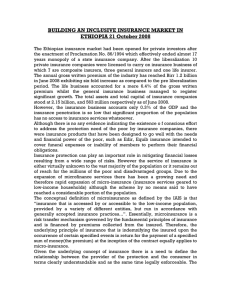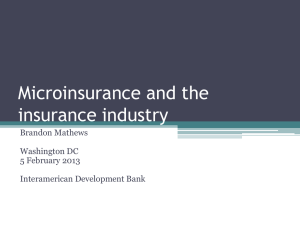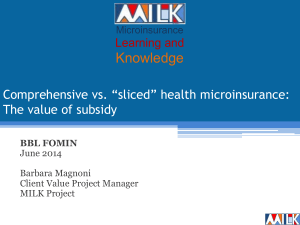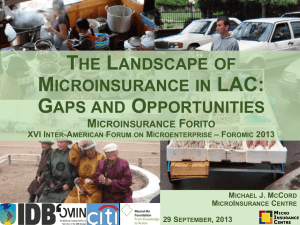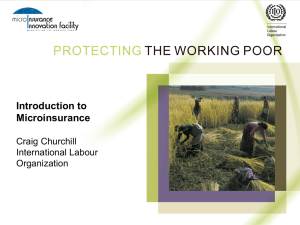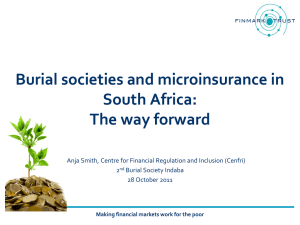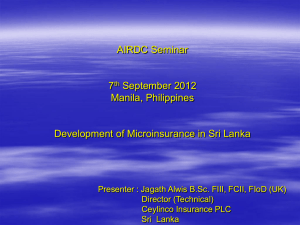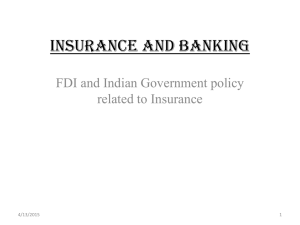Tracing the Insurance Development in Africa
advertisement
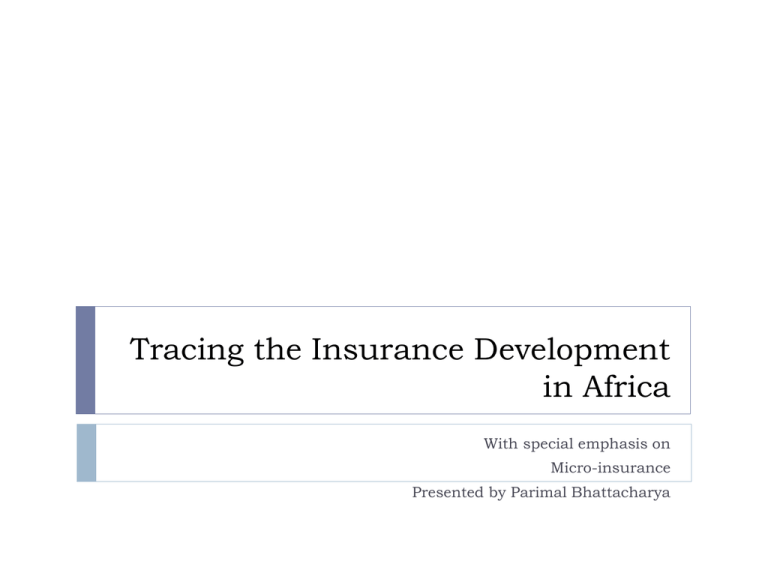
Tracing the Insurance Development in Africa With special emphasis on Micro-insurance Presented by Parimal Bhattacharya Insurance in Africa Due to limited time available, let us right away start with a comparison of Insurance Scenario of Africa in 2005 and in recent times. In 2005, the African continent had a life premium of $ 28 Bn and a non-life premium of $ 12 Bn. The level of Insurance Penetration was 3.33% for life and 1.47% for non-life. The Insurance density was $ 30.7 for life and $13.5 for non-life Comparative Status of Population and GDP Among Select Countries in 2005 (Source: Swiss Re publication for 2005) COUNTRY POPULATION IN Mn LIFE PREMIUM GDP IN Bn USD IN Mn USD NL PREMIUM IN Mn USD AFRICA KENYA 34 34 153 348 NAMIBIA 2 2 350 150 SA 47 240 26000 7300 EGYPT 74 100 300 460 NIGERIA 132 90 70 500 MOROCCO 32 51 370 1100 TUNISIA 10 29 50 540 AFRICA 872 1216 28000 12000 WORLD 6450 44,450 1974000 1450000 Penetration and Density Life Insurance Country Penetration Premium/ GDP KENYA 0.78% NAMIBIA 5.90% SA 10.80% EGYPT 0.34% NIGERIA 0.09% MOROCCO 0.71% TUNISIA 0.17% WORLD 4.30% Insurance Density Premium per capita $5 $172 $558 $4 $0.50 $11.7 $4.8 $300 (Source: Swiss Re publication for 2005) Non-life Insurance Insurance Penetration Density Premium/ Premium per GDP capita 1.79% $10.20 2.46% $73 3.00% $156 0.52% $6.2 0.62% $3.7 2.76% $35.3 1.90% $53.9 3.20% $220 Non-life premium has grown by 4% in 2009, 5.8 in 2010 and 4.9% in 2011 It stood at USD 22 Bn, which is 1.1% of world premium. While Life premium saw a growth of 1.3% in 2011 and stood at USD 46 Bn after seeing a fall of 11% in 2010. That is 1.8% of world premium. Overall situation as of 2010: (Source: Swiss Re publication for 2010) COUNTRY SOUTH AFRICA EGYPT NIGERIA MOROCCO TUNISIA KENYA NAMIBIA TOTAL AFRICA WORLD GROSS DOMESTIC LIFE POPULATION PRODUCT in Bn PREMIUM in in Mn USD Mn USD 50.50 84.5 158.3 32.4 10.4 40.9 2.2 1,031.3 6,917.0 364.00 219.0 208.0 91.0 44.0 32.0 11.0 1,727.0 63,048.0 38667.00 647.0 157.0 825.0 113.0 337.0 610.0 42,796.0 2,507,715.0 NON LIFE PREMIUM in Mn USD 9965.00 938.0 844.0 1,759.0 662.0 661.0 277.0 19,686.0 1,816,524.0 Worldwide position 2010 GROSS DOMESTIC LIFE PRODUCT in Bn PREMIUM USD in Mn USD NON LIFE PREMIUM in Mn USD COUNTRY POPULATI ON in Mn NORTH AMERICA 344.10 16,068 557,007 718,847 LATIN AMERICA AND CARIBBEAN 583.70 4,848 54,458 73,453 EUROPE 811.00 20,066 955,553 657,520 ASIA 4,111.30 18,948 858,466 304,980 AFRICA 1,031.30 1,727 42,796 19,686 35.50 1,392 39,436 42,038 6,917.00 63,048 2,507,715 1,816,524 OCEANIA WORLD 2010 contd. INSURANCE PENETRATION LIFE BUSINESS NON LIFE BUSINESS TOTAL BUSINESS NORTH AMERICA 3.47 4.47 7.94 LATIN AMERICA AND CARIBBEAN 1.12 1.52 2.64 EUROPE 4.44 2.99 7.43 ASIA 4.54 1.59 6.12 AFRICA 2.48 1.14 3.62 SOUTH AFRICA 10.62 2.74 13.35 OCEANIA 2.83 3.02 5.85 WORLD 3.98 2.88 6.86 COUNTRY 2010 contd. INSURANCE DENSITY in USD LIFE BUSINESS NON LIFE BUSINESS TOTAL BUSINESS 1,618.6 2,088.9 3,707.6 93.3 125.8 219.1 1,098.8 740.3 1,839.1 ASIA 209.0 73.2 282.2 AFRICA 41.5 19.1 60.6 SOUTH AFRICA 765.2 197.2 962.4 1,109.3 1,182.6 2,291.9 362.5 262.6 625.2 COUNTRY NORTH AMERICA LATIN AMERICA AND CARIBBEAN EUROPE OCEANIA WORLD 2010 contd.. Low Market penetration (2010, %) 16 14 12 10 Life 8 Non-life Total 6 4 2 0 North America Latin America & Caribbean Europe Asia Oceania Africa including SA SA World 2010 contd.. Low Density (2010, %) 4000 3500 3000 2500 Life 2000 Non-life Total 1500 1000 500 0 North America Latin America & Caribbean Europe Asia Oceania Africa including SA SA World Africa highlights Recent progress Long term opportunities Nine sub-Saharan nations among 15 to grow fastest up to 2015 (Ghana, Tanzania, Zambia, Mozambique, Angola, Liberia, Niger, Rwanda, Sierra Leone). ….forecast by IMF By 2020, half of African household to have income above subsistence level, as per Mckinsey Economies to go beyond ores and oil. E.g. Agriculture (Ethiopia), Telecommunication (Kenya) Insurance industry growing at a faster pace than the economy in the recent past Uncertainty remains a major concern.. on-going issues with legal security, political and economic stability as well as sustainable profitability Comparison with Macroeconomic indicators (Rate of Growth between 2005 and 2011) Positives seen in the last decade liberalization of world trade, increasing efficiency, advances in Information Technology and the integration of world financial system unprecedented positive impact on global growth and development of insurance Unparalleled economic, cultural, and recreational opportunities. New opportunities for insurance business in Africa; as the African market is now open for global exploration and competition. Regulations have created a fairer playing-field for institutions to reach their growth targets..Recent survey by Pricewaterhouse Coopers Inc, concluded from responses of the 27 Companies surveyed Challenges economic consequences of the Global Crisis for the Insurance Industry especially in Africa new challenges for insurance regulation Insurance regulation in Africa is largely compliance based ‘one cap fits all’ approach predominates. same set of rules applied to all No cognizance for the risk profile This model is costly in terms of: finance, manpower and time Added to the cost element is the loss of required effectiveness. Challenges contd.. Capital inadequacy resulting in low retentions and high demand for reinsurance. Globalization & Competition from foreign companies Basic insurance and reinsurance products on offer. Lack of customized insurance solutions to suit local requirements. Weak and unsophisticated supervision (environment for unethical practices to thrive) Many African Countries have weak economies with resultant low Insurance penetration due to lack of disposable income, ignorance and inertia Some countries are beginning to embrace recapitalization, Mergers and Acquisitions (e.g Ghana, Nigeria, Gambia, Kenya to name a few) Development and scope of Micro-insurance in Africa (Findings of a study conducted in 2009 by the International Labour Organization’s (ILO’s) Microinsurance Innovation Facility and the Microinsurance Centre) Definition “an insurance product accessible either by price or delivery channel to people earning less than approximately USD 2 per day” In 2005, just over 0.3%, or 3.5 million low-income people in Africa were accessing microinsurance in eighteen countries out of forty-one that were considered for the study (South Africa was not included in the study). 14.7 million people, or about 2.6% of the population living under USD 2 per day, in 32 countries covered by microinsurance products South Africa alone, represents 8.2 million, or almost 56% of the total Of the 14.7 M, 10.3 M are covered by products other than credit life The total microinsurance premiums received in 2008 amount to about USD 257 million, out of which 88% was collected by regulated insurers. (Number covered in thousands, 2009) Observations Africa remains dominated by life insurance products as seen in Figure above. Of the potential markets, credit life covers close to 9.5%, and other life products cover about 3.2%. Health products, those which are often cited as the most in need, only cover about 0.3% of the low-income population, property and agriculture only about 0.2% and 0.1% respectively of the potential markets. there is still great potential for microinsurance expansion and growth in Africa Range of available products in some countries, such as Kenya, Namibia, Senegal and Cameroon, while others are dominated by few specific product lines Observations contd. Microinsurance has been available to some low-income people in Africa for a number of years in various forms Cooperative Insurers have serviced a market that spans the income ranges since the 1970s. In the 1980s, community-based health insurance schemes, especially in West Africa, In the mid-1990s, commercial insurers began to enter the market offering specialized microinsurance products. Over the last ten years insurance has developed into a widely recognized financial intervention to help Africa’s low-income populations to manage their financial risks Observations contd. Except for North Africa, the regions are more similar in their offering of health microinsurance North Africa looks specifically at the non-life products. The strength in health in Senegal, Benin, Mali, Cameroon and Guinea is directly related to health mutuals Kenya and Uganda it is driven by a mix of community-based schemes and commercial providers Southern and Eastern Africa dominate the microinsurance landscape with 8.8 million and 4 million lives covered This leaves only 1.9 million covered in Central, North, and West Africa. This can be explained partly due to the strength of life microinsurance in South Africa, as well as the engagement of commercial insurers in microinsurance in the East and South Microinsurance is on the rise A comparison with 2005 indicates that the number of lives covered almost doubled in three years. The growth seems to be more substantial in recent years. Half of the schemes were growing at a rate higher than 30% per year “Insurers” are defined here as institutions that manage insurance risk. These include: Regulated insurers include commercial insurers and cooperative or mutual insurance companies, regulated by the insurance regulations Health mutuals and community-based microinsurance programs Microfinance institutions (MFIs), non-governmental organizations (NGOs), hospitals and others that manage their own unregulated insurance programs Share of various Risk Carriers… In Millions, year 2009 Observations Regulated insurers dominate the life landscape 1.5 million receiving credit life insurance primarily from their MFI Health mutuals focusing entirely on health care financing 1.2 million covered by health mutuals, and 0.8 million covered by regulated insurers and other risk carriers. It is important to support the development of various models to expand microinsurance across the low-income market Some institutional types may be better at focusing on poorer target groups while others might be more effective in the slightly less poor markets African micro-insurers offer a wide variety of microinsurance products. Though life insurance is clearly predominant, efforts to provide other products are an important response to market demands Other insurers can learn from this This will greater variety of mass sales of these other products Observation contd Total of 9.1 million people had life cover Of these, Funeral and personal accident insurance cover about 6.2 million High funeral cover numbers are related to cultural issues in South Africa. This shows that cultural factors play an important role in microinsurance market development. Swiss Re (Sigma3 2009) reports South Africa as having the third highest life insurance penetration in the world. Term life policies (4.8 million) are popularly offered in many African countries. Endowment policies (0.8 million) are comparatively lesser Observation contd. Credit life insurance, is commonly a required purchase with microcredit and other borrowing. It touches the most people in Africa – 7 million – Easy to require borrowers to purchase it It can be very profitable, especially since borrowers are often not aware that they have purchased insurance with their loan At least 25% of those covered by credit life enjoy an addon that accrue to their surviving family. Health products cover at least 1.9 million people 1.3 million enjoy comprehensive Health packages, mostly delivered by health mutuals or specialized commercial players. Agriculture Insurance and Business Property Less than 80,000 covered between livestock, crop and various agriculture related index products. This shows there is need to find better tools for farmers. Recent developments in index microinsurance products offer the potential of a major breakthrough for agriculture. These products are still being tested and generally have limited acceptance Less than 0.3 million access non-agriculture related property insurance. Business property cover stands out in this group, but still with only 140,000 policyholders. The way forward… If microinsurance is to prove effective as a risk management strategy for low-income households in Africa, risk carriers will need to better reflect the demands of the market in their product offerings, while still ensuring viability.
